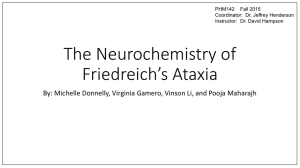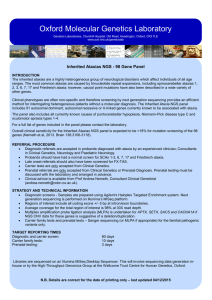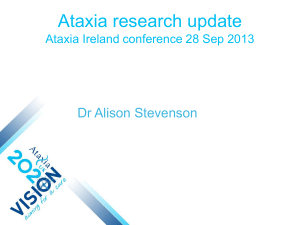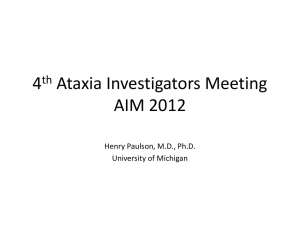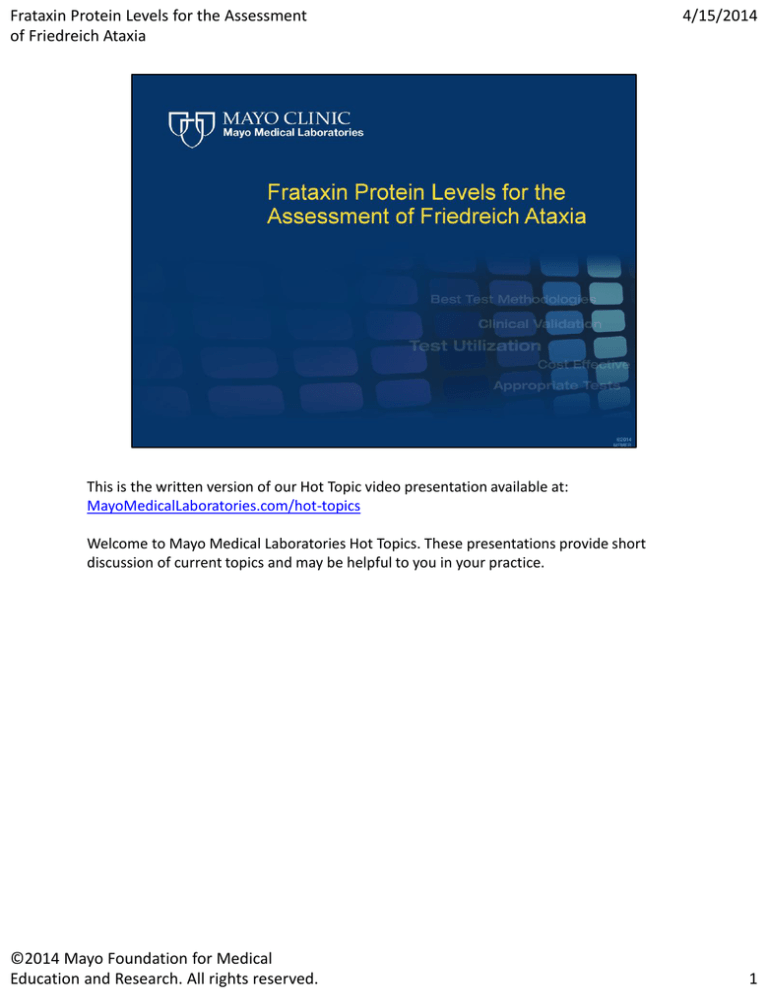
Frataxin Protein Levels for the Assessment
of Friedreich Ataxia
4/15/2014
This is the written version of our Hot Topic video presentation available at:
MayoMedicalLaboratories.com/hot-topics
Welcome to Mayo Medical Laboratories Hot Topics. These presentations provide short
discussion of current topics and may be helpful to you in your practice.
©2014 Mayo Foundation for Medical
Education and Research. All rights reserved.
1
Frataxin Protein Levels for the Assessment
of Friedreich Ataxia
4/15/2014
Our speaker for this program is Dr. Devin Oglesbee, Consultant in Laboratory Genetics and
Medical Genetics at Mayo Clinic, Rochester, Minnesota. Dr. Oglesbee discusses Friedreich
ataxia—clinical presentation, the natural history of the disorder, and a new laboratory test
for diagnosis.
©2014 Mayo Foundation for Medical
Education and Research. All rights reserved.
2
Frataxin Protein Levels for the Assessment
of Friedreich Ataxia
4/15/2014
Thank you for the introduction, I have nothing to disclose.
©2014 Mayo Foundation for Medical
Education and Research. All rights reserved.
3
Frataxin Protein Levels for the Assessment
of Friedreich Ataxia
4/15/2014
And also, thank you for taking the time to learn more about a new test offered by Mayo
Medical Laboratories. Today, I will discuss a new diagnostic assay for an inherited
neurological disorder, Friedreich ataxia, based on the analysis of a protein, frataxin.
Besides informing you about the new opportunity to quickly detect this disease, I would
also like to educate you about the clinical presentation, natural history, and potential
therapies available for this progressive neurological condition.
Moreover, I will touch on the utility of protein-based Friedreich ataxia diagnostic testing,
covering the acceptable specimen types, the assay method, its performance, and provide
an update on testing recommendations in light of the availability of this new assay.
©2014 Mayo Foundation for Medical
Education and Research. All rights reserved.
4
Frataxin Protein Levels for the Assessment
of Friedreich Ataxia
4/15/2014
As you are aware there are numerous hereditary ataxias, encompassing a large and diverse
group of degenerative diseases of the nervous system. And it is difficult to distinguish
hereditary ataxias from acquired or sporadic forms of this condition.
While incoordination, or ataxia, are a collective presentation and a common manifestation,
the occurrence of hereditary ataxia is not confined to an early disease onset. Indeed, there
are also adult-presenting hereditary ataxias that are led by a long latent phase. Moreover,
the severity of disease symptoms will depend on the age of onset, type of condition, and
other poorly understood factors that might include environmental exposure and yet-to-be
identified genetic modifiers.
©2014 Mayo Foundation for Medical
Education and Research. All rights reserved.
5
Frataxin Protein Levels for the Assessment
of Friedreich Ataxia
4/15/2014
The most common inherited ataxia is called Friedreich ataxia. It was originally described by
the German professor, pathologist, and neurologist, Nicolaus Friedreich, at the prestigious
University of Heidelberg in Germany. He published a series of publications recounting a
family with numerous affected individuals. Professor Friedreich noted that the condition
caused progressive sensory loss, muscle weakness, and ataxia.
Further clinical research over the last 150 years, summarized on the table on the right, has
recognized that Friedreich ataxia presents with a variety of different conditions and
symptoms: progressive ataxia, dysarthria in the form of slurred speech, absent lower limb
reflexes, scoliosis, and pes cavus. And in the majority of affected individuals, you will see
that cardiomyopathy develops and is a high cause of mortality. Affected individuals are at
an increased risk for vision loss, hearing impairment, diabetes, and swallowing difficulties
as shown by the percentages of individuals with these symptoms from several different
large case series published to date.
©2014 Mayo Foundation for Medical
Education and Research. All rights reserved.
6
Frataxin Protein Levels for the Assessment
of Friedreich Ataxia
4/15/2014
More recently, it has been observed that there is a demarcation in the clinical presentation
of Friedreich ataxia. In particular, that there are different forms of the disease, often called
classic or atypical Friedreich ataxia.
For classic Friedreich ataxia, the onset of symptoms occurs in childhood or early teens with
poor balance, progressive speech impairment, and upper-limb ataxia. The age of onset can
be between 10 to 15 years of age.
Slide 8. Natural History
In over 60% of classic Friedreich ataxia, hypertrophic cardiomyopathy will develop and lead
to the risk of arrhythmias and congestive heart failure in early life. The progression of these
symptoms is difficult to predict and may depend on a variety of modulators.
In contrast, atypical Friedreich ataxia is often divided into 2 groups based on the age of
presentation. Late-onset Friedreich ataxia frequently refers to individuals who become
progressively ataxic by 25 to 39 years of age. While very-late onset Friedreich ataxia
describes individuals who are symptomatic above the age of 40.
For both late-onset and very-late onset Friedreich ataxia, the disease progression is slower
than classic Friedreich ataxia and the co-morbidities may also be different or delayed.
©2014 Mayo Foundation for Medical
Education and Research. All rights reserved.
7
Frataxin Protein Levels for the Assessment
of Friedreich Ataxia
4/15/2014
The prevalence of Friedreich ataxia is rare in the general population, with an incidence
around 1 in 50,000 individuals depending on ancestry. For individuals with European,
Indian, and Middle-Eastern descent, it is the most common inherited ataxia. In contrast, the
condition appears to be absent in populations with Southeast Asian, Sub-Saharan African,
or Native American ancestry.
©2014 Mayo Foundation for Medical
Education and Research. All rights reserved.
8
Frataxin Protein Levels for the Assessment
of Friedreich Ataxia
4/15/2014
Friedreich ataxia is different from sporadic or acquired ataxias due to the very fact that it is
inherited in the following manner, as diagramed on the right. Unaffected parents can pass
copies of a defective Friedreich ataxia gene onto all future offspring, such that their
children have an equal opportunity to present with Friedreich ataxia at a rate of 25%. In
addition, 50% of offspring could be asymptomatic carriers, just like their parents. This type
of inheritance is called autosomal recessive, as it requires 2 defective copies of a gene to
dictate a clinical presentation. Thus, unless there is genetic intervention before each
pregnancy, every child has the same risk (1 in 4) of being affected.
©2014 Mayo Foundation for Medical
Education and Research. All rights reserved.
9
Frataxin Protein Levels for the Assessment
of Friedreich Ataxia
4/15/2014
Friedreich ataxia is different from sporadic or acquired ataxias due to the very fact that it is
inherited in the following manner, as diagramed on the right. Unaffected parents can pass
copies of a defective Friedreich ataxia gene onto all future offspring, such that their
children have an equal opportunity to present with Friedreich ataxia at a rate of 25%. In
addition, 50% of offspring could be asymptomatic carriers, just like their parents. This type
of inheritance is called autosomal recessive, as it requires 2 defective copies of a gene to
dictate a clinical presentation. Thus, unless there is genetic intervention before each
pregnancy, every child has the same risk (1 in 4) of being affected.
©2014 Mayo Foundation for Medical
Education and Research. All rights reserved.
10
Frataxin Protein Levels for the Assessment
of Friedreich Ataxia
4/15/2014
The mutations that cause Friedreich ataxia are found in the FXN gene on chromosome
9q21.11. This gene encodes for a mitochondrial protein, frataxin, which has several unique
functions in the mitochondria and cell. Specifically, it is involved in the biosynthesis of ironsulfur clusters in enzymes involved in metabolism. It is also important for iron localization
and impacts iron distribution in the cell. Also, when frataxin is present, it reduces ironmediated oxidative damage.
Mutations that cause Friedreich ataxia lead to reduced frataxin levels in all tissues. The
most common cause of Friedreich ataxia is GAA-trinucleotide repeat expansions that are
found in intron 1 of FXN.
©2014 Mayo Foundation for Medical
Education and Research. All rights reserved.
11
Frataxin Protein Levels for the Assessment
of Friedreich Ataxia
4/15/2014
In most individuals, intron 1 of FXN contains a small number of GAA repeats, often less
than 33-trinucleotide repeats. There are some people, perhaps as many as 1 in 100, where
intron 1 of FXN contains an expanded GAA-trinucleotide repeat, more than 66 repeats and
as many as 1700 repeats. The outcome of GAA-repeats greater than 66 is the loss of FXN
expression. When this occurs, RNA is not synthesized due to the fact that the FXN gene
becomes more tightly bound to acetylated histones when a large GAA-repeat expansion is
present. This turns off the gene, and in turn, leads to the loss of frataxin protein levels.
©2014 Mayo Foundation for Medical
Education and Research. All rights reserved.
12
Frataxin Protein Levels for the Assessment
of Friedreich Ataxia
4/15/2014
While GAA-repeats greater than 66 lead to reduced frataxin and disease, classic Friedreich
ataxia is associated with even longer GAA-repeat lengths, commonly greater than 500
repeats, or more, on both alleles.
In 2 to 5% of patients, Friedreich ataxia is caused by a point mutation inherited opposite a
GAA-repeat expansion allele. These point mutations are often exonic and lead to amino
acid changes that reduce frataxin levels.
In rare circumstances, Friedreich ataxia is caused by a full or partial gene deletion that is
inherited opposite another mutation. Deletions also lead to lower frataxin levels.
©2014 Mayo Foundation for Medical
Education and Research. All rights reserved.
13
Frataxin Protein Levels for the Assessment
of Friedreich Ataxia
4/15/2014
Laboratory testing is very important for the detection and diagnosis of Friedreich ataxia.
Traditionally, DNA testing is performed to measure GAA-repeat length sizes. The laboratory
analytical time for the analysis of GAA-repeat lengths in whole blood DNA can be as long as
14 days. Moreover, a big pitfall to the DNA GAA-repeat length measurement method is the
fact that is misses point mutations and deletions unless it is coupled with other DNA
analytical methods.
To address this shortfall, molecular genetic laboratories often include DNA gene
sequencing alongside GAA-repeat length determination. This DNA panel testing has
increased the sensitivity of DNA-based methods but also is unable to detect exonic
deletions unless it incorporates additional analytical methods, like deletion/duplication
arrays or a method called MLPA. Deletion testing is not broadly used by laboratories at this
time.
©2014 Mayo Foundation for Medical
Education and Research. All rights reserved.
14
Frataxin Protein Levels for the Assessment
of Friedreich Ataxia
4/15/2014
In order to side-step the shortcomings of DNA testing, we developed and validated an
analytical method to diagnose Friedreich ataxia by measuring frataxin levels from whole
blood or dried blood spots. The protein-based assay is specific and sensitive for Friedreich
ataxia, just like the DNA panel test. However, it is also applicable to therapeutically monitor
blood levels of frataxin, it is multiplexible with other analytes, and useful for highthroughput screening, or HTS screening, and is a cost-effective method to diagnose
Friedreich ataxia. And, as with other protein assays, it is more easily reimbursable than
DNA-based genetic testing. Lastly, it is not recommended to be used to determine carrier
status, which is one of the applications of DNA panel testing.
©2014 Mayo Foundation for Medical
Education and Research. All rights reserved.
15
Frataxin Protein Levels for the Assessment
of Friedreich Ataxia
4/15/2014
The protein-based assay uses immunocapture methods to measure frataxin levels. As
shown here in step 1, fluorescent microbeads are coated with frataxin-specific capture
antibodies. Dried blood spot or whole blood eluents are incubated with coated microbeads
and the antibodies bind available frataxin. In step 3, a detection antibody is added to the
frataxin-coated beads, which sandwiches the frataxin between 2 antibodies and permits
the bead to be labeled by a fluorescent reporter dye, shown in step 4. The fluorescence of
each bead is counted and correlated with a standard recombinant protein curve in order to
determine endogenous frataxin levels in a sample. As with all microbead assays, there is
the capability to mix microbeads specific to different analytes together. In our assay, we
used a second protein, as an internal control alongside the target protein, frataxin.
©2014 Mayo Foundation for Medical
Education and Research. All rights reserved.
16
Frataxin Protein Levels for the Assessment
of Friedreich Ataxia
4/15/2014
The frataxin assay can be performed on 2 different types of specimens, whole blood or
dried blood spots. Whole blood collected in EDTA, sodium or lithium heparin. Blood is
acceptable up to 70 days if kept frozen. In contrast, dried blood spots can be collected onto
1 of 3 different types of paper, commonly used for newborn screening, such as Whatman
903 paper or the Mayo Clinic Supplemental newborn screening card. Dried blood spots are
stable at room temperature for up to 30 days.
©2014 Mayo Foundation for Medical
Education and Research. All rights reserved.
17
Frataxin Protein Levels for the Assessment
of Friedreich Ataxia
4/15/2014
Reference values are slightly different between pediatric and adult individuals. For
individuals less than 18 years of age, normal frataxin levels are greater or equal to 19
ng/mL, while adults have frataxin levels that are greater than 21 ng/mL. A normal result is
reported for any individual whose frataxin levels are measured above 19 or 21 ng/mL,
depending on age. For every test, an interpretation about the clinical significance of the
result is also provided with each report. Moreover, as mentioned previously, frataxin blood
levels are not recommended for determining carrier status for Friedreich ataxia.
©2014 Mayo Foundation for Medical
Education and Research. All rights reserved.
18
Frataxin Protein Levels for the Assessment
of Friedreich Ataxia
4/15/2014
The performance of the assay for measuring blood frataxin levels is excellent. As seen on
the top panel on the right-hand side, a simple regression analysis of titrated frataxin levels
results in a coefficient of determination, or R-squared, of 0.99985. The linearity has been
determined out to 200 ng/mL, and the limit of detection is less than 1 ng/mL.
On the lower panel, a box-and-whisker plot shows normal and disease ranges. In green,
you can observe that the normal range starts at 19 or 21 ng/mL and extends up to greater
than 80 ng/mL. In contrast, the affected range for Friedreich ataxia, seen labeled as in red
as FA on the far right hand side, ranges from 1 to12 ng/mL, and is easily distinguishable
from normal individuals. Also observed, are frataxin levels measured for very-late onset
Friedreich ataxia patients, labeled here as VLO-FA. These individuals have frataxin levels
slightly below the normal range, but can also overlap frataxin levels measured in a cohort
of Friedreich ataxia carriers, making the protein assay ineffective for the determination of
carrier status as it cannot exclude the possibility of a diagnosis of very-late onset Friedreich
ataxia.
©2014 Mayo Foundation for Medical
Education and Research. All rights reserved.
19
Frataxin Protein Levels for the Assessment
of Friedreich Ataxia
4/15/2014
The imprecision of the frataxin assay is shown on the following slide. On the top table,
intraassay imprecision coefficient of variation, or CV, is characterized. As seen for blood or
dried blood spot, frataxin levels, or FXN, is less than 15% for protein levels at 3 different
levels. For interassay imprecision, the percent coefficient of variation is a little larger but
ranges from 9.8 to 15.8%.
©2014 Mayo Foundation for Medical
Education and Research. All rights reserved.
20
Frataxin Protein Levels for the Assessment
of Friedreich Ataxia
4/15/2014
As shown by the details of assay performance, the protein-based test for frataxin is useful
for obtaining a diagnosis and excluding Friedreich ataxia from a list of potential differential
diagnoses.
In contrast, DNA panel testing can be used for detecting Friedreich ataxia but it is especially
helpful to determine carrier status in asymptomatic individuals, measuring GAA-repeat
lengths, and confirming point mutations or deletions.
©2014 Mayo Foundation for Medical
Education and Research. All rights reserved.
21
Frataxin Protein Levels for the Assessment
of Friedreich Ataxia
4/15/2014
The availability of an assay for frataxin can expedite a diagnosis of Friedreich ataxia if the
testing strategy that is shown in this diagram is followed. First, if there is a clinical suspicion
of Friedreich ataxia, or listed here as FRDA, the best assay is a quantitative frataxin level in
dried blood spot or blood. This single assay will allow you to obtain a diagnosis, if frataxin
levels are low, or refute the possibility of Friedreich ataxia, if measured levels are within the
normal range. In the rare circumstance that a result for frataxin is close, but not within the
normal range, for instance, a blood level of 19 ng/mL for an adult whose normal range
begins at 21 ng/mL; carrier status cannot be excluded. In this rare circumstance, we
recommended considering DNA panel testing, followed by deletion testing, if needed. For
all normal results, there are other inherited ataxias that should be part of a differential
diagnosis for individuals presenting with symptoms similar to Friedreich ataxia.
©2014 Mayo Foundation for Medical
Education and Research. All rights reserved.
22
Frataxin Protein Levels for the Assessment
of Friedreich Ataxia
4/15/2014
When faced with normal frataxin results, consider the following conditions listed on this
slide that should be part of every Friedreich ataxia differential diagnosis.
©2014 Mayo Foundation for Medical
Education and Research. All rights reserved.
23
Frataxin Protein Levels for the Assessment
of Friedreich Ataxia
4/15/2014
While most treatment for Friedreich ataxia has not been shown to alter its natural history,
and encompasses standard management of heart failure, arrhythmias, diabetes, hearing
loss, and the like, there is a growing pipeline of new experimental therapies that may show
promise from further study. There are clinical trials for compounds that reduce oxidative
stress and increase mitochondrial function, such as coenzyme-Q and vitamin E.
There are also other compounds under review that aim to modulate frataxin-mediated
metabolic pathways through nutritional approaches or by specifically activating a protein,
Nrf2, a transcription factor important for antioxidant pathways.
Moreover, there is research on erythropoietin, or EPO, that demonstrate that this growth
factor can enhance or stabilize frataxin in blood specimens. Although, additional research is
needed to determine whether this induction is blood-specific or more widespread.
Additional compounds that show therapeutic promise are specific histone-deacetylase
inhibitors that can apparently relax the tight GAA-repeat length-mediated silencing of the
FXN gene, and increase frataxin expression. But further work is needed to ensure that
unique HDAC inhibitors, such as these, are capable to specifically target frataxin protein
expression without toxic side effects.
Lastly, gene therapy, through the introduction of copies of normal FXN genes, is also a
pipeline of potential therapy.
©2014 Mayo Foundation for Medical
Education and Research. All rights reserved.
24
Frataxin Protein Levels for the Assessment
of Friedreich Ataxia
4/15/2014
For more information about Friedreich ataxia, I recommend a couple of resources that are
helpful for both healthcare practitioners and patients. First, the Friedreich Ataxia Research
Alliance, and its website, www.curefa.org, is very informative. In addition, the National
Ataxia Foundation, the Muscular Dystrophy Association, the Office of Rare Diseases
Research, and for contact information on current clinical trials, look at
www.clinicaltrials.gov
This ends my presentation on frataxin protein testing, and I thank you for your attention
and I hope that you found this presentation to be educational.
©2014 Mayo Foundation for Medical
Education and Research. All rights reserved.
25
Frataxin Protein Levels for the Assessment
of Friedreich Ataxia
©2014 Mayo Foundation for Medical
Education and Research. All rights reserved.
4/15/2014
26

